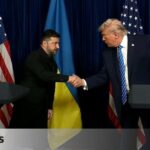
Russia launches 537 air weapons in 48 hours and exposes Ukrainian military fragility in the face of a West that promises a lot, but delivers little
Russia launched, at dawn on Sunday (29), the biggest air strike since the beginning of the invasion in 2022, marking a significant escalation in its war strategy and undermining any hope of ceasing fire in a conflict that enters its fourth year. According to the Ukrainian government, Moscow fired 537 aerial weapons into one night, including 477 explosive drones and 60 missiles of different types. Of the threats, 211 drones and 38 missiles were slaughtered by the Ukrainian defenses, but the damage was substantial.
The attack, which hit cities like Kherson, Kharkiv and Lviv, left a trail of destruction in critical and residential infrastructure. In Smila, Cherkasy region, rescue teams worked tirelessly to contain fires and rescue victims after attacks that destroyed buildings and left civilians homeless.
“Moscow is trying to crush our defense capacity and test our psychological resistance,” said Rustem Umarov, Ukrainian Defense Minister, noting that Russian drones, many of them based on the Iranian model Shahed, now fly louder and faster, making their interception difficult.
The Russian strategy also charged a human price. A Ukrainian Air Force pilot, General Maksym Ustymenko, died after slaughtering seven enemy targets with his F-16 fighter, but losing control of the aircraft when hit.
In Kherson, a civilian was killed by a drone; In Kharkiv, two men lost their lives when they had their car hit. Hundreds sought refuge in subway stations and underground shelters, while explosions echoed in various cities.
President Volodymyr Zelensky, in a message on social networks, asked Western countries to accelerate the sending of anti -aircraft defense systems. “We need to protect lives with advanced technology, such as the American systems we are willing to buy,” he said, warning that Moscow will not stop while he is able to attack. His statement included criticism of US refusal to sell new Patriot missiles, essential equipment to contain the Russian climb.
Meanwhile, Ukraine announced the departure of the Treaty of Ottawa, which prohibits antipersal mines, after Zelenski signs a decree allowing its use. The parliamentarian Roman Kostenko justified the measure by stating that Russia, not signatory to the agreement, already employs mines against civilian civilians and troops. “We cannot follow rules that the enemy ignores,” he wrote on a social network.
On the east front, chief commander Oleksandr Syrsky warned that Russian forces advance with record speed, using guided pumps and fiber optic drones to try to surround strategic cities such as KostyAntynivka and Pokrovsk. In the north, Kursk troops approach Sumy, placing the regional capital in artillery range.
Analyzes indicate that war tends to intensify in the European summer, with Moscow prioritizing the exhaustion of Ukrainian defenses and psychological pressure. While Kiev insists on the need for western support, criticism of NATO grows among experts who see an aggravating factor in the alliance. “The entry of Ukraine in NATO would be a trigger for a larger war,” historian Sergiy Kudelia recently said in an interview with BBC .
With limited resources and an adaptive enemy, Ukraine faces a dilemma: continuing depending on foreign armaments or seeking internal solutions to counteract the Russian war machine. Meanwhile, civilians pay the price of the prolonged geopolitical battle, where the line between defense and aggression becomes increasingly faint.
With information from Financial Times*
Source: https://www.ocafezinho.com/2025/06/30/ucrania-sente-bombardeio-mais-intenso-desde-2022/

